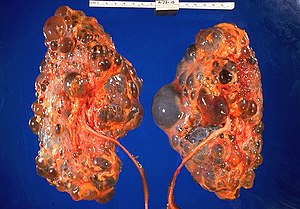Cystic kidney diseases
Cystic kidney diseases, also cystic renal diseases, are a group of medical kidney diseases characterized by multiple cysts.
Renal neoplasms, e.g. renal cell carcinoma, may be cystic. They are dealt with in kidney tumours.
Overview
Adult
- Autosomal dominant polycystic kidney disease (ADPKD).
- Adult-onset medullary cystic disease.
- Acquired renal cystic disease.
- Cystic renal cell carcinoma.
- Localized cystic disease of the kidney.
Pediatric
- Autosomal recessive polycystic kidney disease (ARPKD).
- Medullary sponge kidney.
- Nephronophthisis.
Specific diseases
Benign cortical cyst of the kidney
- AKA benign cortical cyst.
Main article: Benign cortical cyst of the kidney
Autosomal dominant polycystic kidney disease
- Abbreviated ADPKD.
General
Etiology
- Mutation in PKD1 gene or PKD2 gene.
- Is classified in a large group of diseases - ciliopathies.
PKD1 related disease:[1]
- Encodes polycystin.
- Death at ~53 years.
- Assoc. with cerebral aneurysms.
PKD2 related disease:[1]
- Death at ~69 years.
- Associated with colonic diverticula, aortic aneurysm, mitral valve prolapse.
Liver cysts and PKD
General
Features:
- Most common extra-renal manifestation of PKD; dependent on age, sex and renal function:[2]
- Age dependence:
- 10-17% <40 years old have liver cysts.
- 70-75% >60 years old have liver cysts.
- Renal function:
- 60-70% of patients with end-stage renal disease (ESRD) and near-ESRD.
- Females more often affected.
- Age dependence:
- Hepatic function usu. preserved.
Complications:[1]
- Infected cyst.
- Cholangiocarcinoma.
Microscopic
Features:
- Von Meyenburg complexes:
- Cluster of dilated ducts with "altered" bile.
- Surrounded by collagenous stroma.
See: Medical liver disease.
Gross
Features:
- Thin walled cysts.
- Number of cysts:
- If you can count 'em it favours acquired renal cystic disease... if you can't it favours the genetic condition.
- Number of cysts:
Microscopic
Features:[3]
- Cysts lined by simple flattened epithelium.
- Normal renal tubules interspersed between cysts.
- +/-Fibrosis (late-stage).
DDx:
- Acquired renal cystic disease - rarely.[4]
Sign out
Left Kidney, Nephrectomy: - Polycystic kidney with changes of chronic renal failure (thyroidization), consistent with polypcystic kidney disease. - NEGATIVE for malignancy.
Acquired renal cystic disease
Main article: Acquired cystic disease of the kidney
Autosomal recessive polycystic kidney disease
- Abbreviated ARPKD.
Main article: Autosomal recessive polycystic kidney disease
Localized cystic disease of the kidney
- AKA segmental cystic disease of the kidney.
- AKA unilateral cystic disease of the kidney.
- AKA benign multilocular cyst of the kidney.
Main article: Localized cystic disease of the kidney
See also
References
- ↑ 1.0 1.1 1.2 Burt, Alastair D.;Portmann, Bernard C.;Ferrell, Linda D. (2006). MacSween's Pathology of the Liver (5th ed.). Churchill Livingstone. pp. 174-5. ISBN 978-0-443-10012-3.
- ↑ Perrone RD (June 1997). "Extrarenal manifestations of ADPKD". Kidney Int. 51 (6): 2022–36. PMID 9186898. http://www.nature.com/ki/journal/v51/n6/pdf/ki1997276a.pdf.
- ↑ Fogo, Agnes B.; Kashgarian, Michael (2005). Diagnostic Atlas of Renal Pathology: A Companion to Brenner and Rector's The Kidney 7E (1st ed.). Saunders. pp. 426. ISBN 978-1416028710.
- ↑ Kessler M, Testevuide P, Aymard B, Huu TC (1991). "Acquired renal cystic disease mimicking adult polycystic kidney disease in a patient undergoing long-term hemodialysis". Am. J. Nephrol. 11 (6): 513–7. PMID 1819219.
- ↑ 5.0 5.1 RJ. 20 October 2010.
- ↑ Barbaric, Zoran L. (1994). Principles of Genitourinary Radiology (2nd ed.). Thieme. pp. 87. ISBN 978-0865774933.
